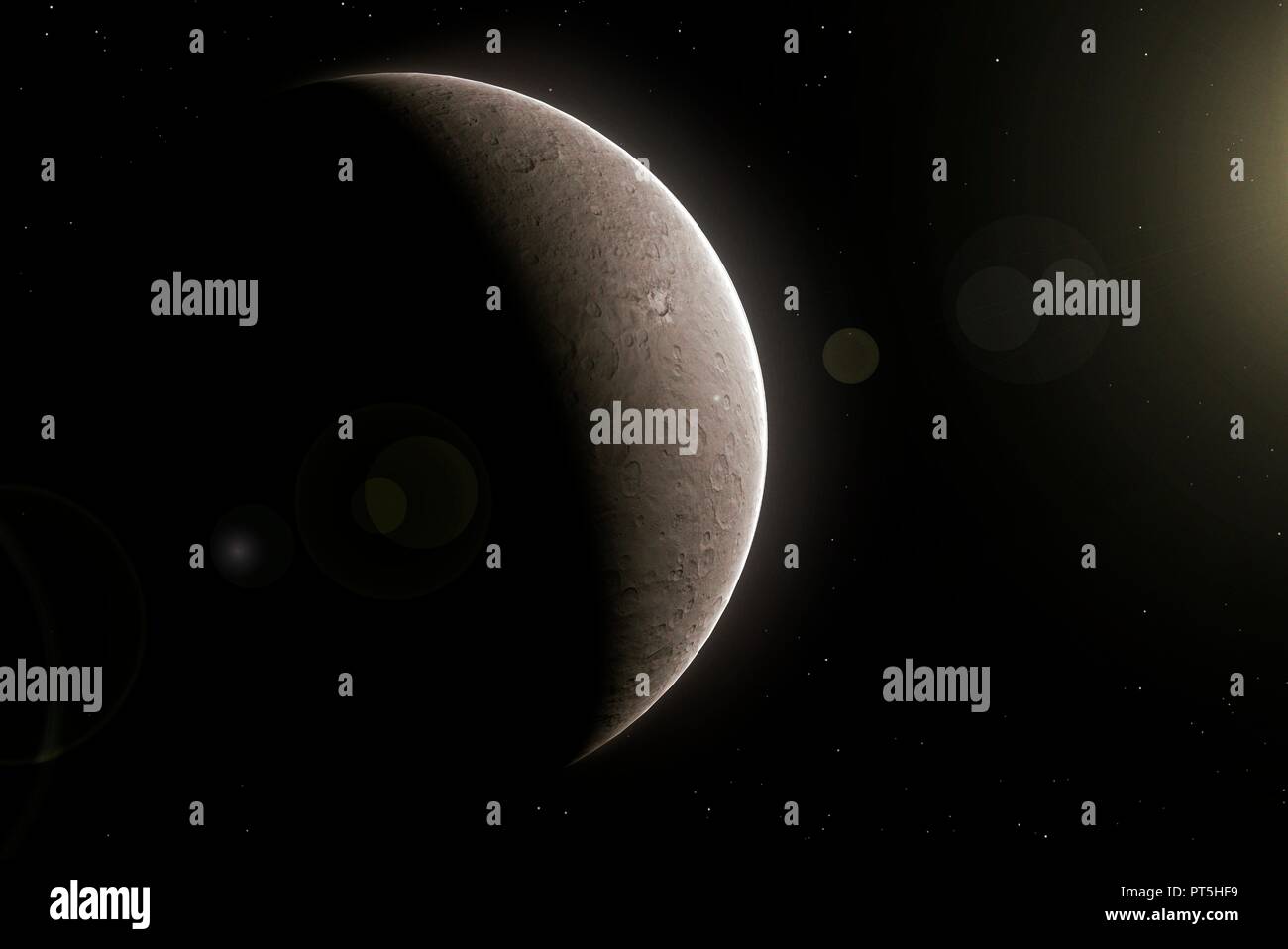···
Ceres, illustration. Ceres is a dwarf planet, the only one that orbits in the asteroid belt. It is also an asteroid, the largest one known, and the first to be discovered, in 1801. The surface of Ceres is heavily cratered due to impacts from meteorites. It orbits the Sun at an average distance of 2.76 astronomical units (AU), and has a mean radius of 473 km - large enough for it to be spherical. It has been studied by the spacecraft Dawn, which entered into orbit around the mini-world in March 2015. Image details File size:
50 MB (410.1 KB Compressed download)
Open your image file to the full size using image processing software.
Dimensions:
5115 x 3417 px | 43.3 x 28.9 cm | 17.1 x 11.4 inches | 300dpi
Date taken:
10 August 2018
Search stock photos by tags
Similar stock images Ceres, illustration. Ceres is a dwarf planet, the only one that orbits in the asteroid belt. It is also an asteroid, the largest one known, and the first to be discovered, in 1801. The surface of Ceres is heavily cratered due to impacts from meteorites. It orbits the Sun at an average distance of 2.76 astronomical units (AU), and has a mean radius of 473 km - large enough for it to be spherical. It has been studied by the spacecraft Dawn, which entered into orbit around the mini-world in March 2015. Stock Photo https://www.alamy.com/image-license-details/?v=1 https://www.alamy.com/ceres-illustration-ceres-is-a-dwarf-planet-the-only-one-that-orbits-in-the-asteroid-belt-it-is-also-an-asteroid-the-largest-one-known-and-the-first-to-be-discovered-in-1801-the-surface-of-ceres-is-heavily-cratered-due-to-impacts-from-meteorites-it-orbits-the-sun-at-an-average-distance-of-276-astronomical-units-au-and-has-a-mean-radius-of-473-km-large-enough-for-it-to-be-spherical-it-has-been-studied-by-the-spacecraft-dawn-which-entered-into-orbit-around-the-mini-world-in-march-2015-image221399681.html RF PT5HFD – Ceres, illustration. Ceres is a dwarf planet, the only one that orbits in the asteroid belt. It is also an asteroid, the largest one known, and the first to be discovered, in 1801. The surface of Ceres is heavily cratered due to impacts from meteorites. It orbits the Sun at an average distance of 2.76 astronomical units (AU), and has a mean radius of 473 km - large enough for it to be spherical. It has been studied by the spacecraft Dawn, which entered into orbit around the mini-world in March 2015. Ceres, illustration. Ceres is a dwarf planet, the only one that orbits in the asteroid belt. It is also an asteroid, the largest one known, and the first to be discovered, in 1801. The surface of Ceres is heavily cratered due to impacts from meteorites. It orbits the Sun at an average distance of 2.76 astronomical units (AU), and has a mean radius of 473 km - large enough for it to be spherical. It has been studied by the spacecraft Dawn, which entered into orbit around the mini-world in March 2015. Stock Photo https://www.alamy.com/image-license-details/?v=1 https://www.alamy.com/ceres-illustration-ceres-is-a-dwarf-planet-the-only-one-that-orbits-in-the-asteroid-belt-it-is-also-an-asteroid-the-largest-one-known-and-the-first-to-be-discovered-in-1801-the-surface-of-ceres-is-heavily-cratered-due-to-impacts-from-meteorites-it-orbits-the-sun-at-an-average-distance-of-276-astronomical-units-au-and-has-a-mean-radius-of-473-km-large-enough-for-it-to-be-spherical-it-has-been-studied-by-the-spacecraft-dawn-which-entered-into-orbit-around-the-mini-world-in-march-2015-image221399675.html RF PT5HF7 – Ceres, illustration. Ceres is a dwarf planet, the only one that orbits in the asteroid belt. It is also an asteroid, the largest one known, and the first to be discovered, in 1801. The surface of Ceres is heavily cratered due to impacts from meteorites. It orbits the Sun at an average distance of 2.76 astronomical units (AU), and has a mean radius of 473 km - large enough for it to be spherical. It has been studied by the spacecraft Dawn, which entered into orbit around the mini-world in March 2015. Ceres, illustration. Ceres is a dwarf planet, the only one that orbits in the asteroid belt. It is also an asteroid, the largest one known, and the first to be discovered, in 1801. The surface of Ceres is heavily cratered due to impacts from meteorites. It orbits the Sun at an average distance of 2.76 astronomical units (AU), and has a mean radius of 473 km - large enough for it to be spherical. It has been studied by the spacecraft Dawn, which entered into orbit around the mini-world in March 2015. Stock Photo https://www.alamy.com/image-license-details/?v=1 https://www.alamy.com/ceres-illustration-ceres-is-a-dwarf-planet-the-only-one-that-orbits-in-the-asteroid-belt-it-is-also-an-asteroid-the-largest-one-known-and-the-first-to-be-discovered-in-1801-the-surface-of-ceres-is-heavily-cratered-due-to-impacts-from-meteorites-it-orbits-the-sun-at-an-average-distance-of-276-astronomical-units-au-and-has-a-mean-radius-of-473-km-large-enough-for-it-to-be-spherical-it-has-been-studied-by-the-spacecraft-dawn-which-entered-into-orbit-around-the-mini-world-in-march-2015-image221399662.html RF PT5HEP – Ceres, illustration. Ceres is a dwarf planet, the only one that orbits in the asteroid belt. It is also an asteroid, the largest one known, and the first to be discovered, in 1801. The surface of Ceres is heavily cratered due to impacts from meteorites. It orbits the Sun at an average distance of 2.76 astronomical units (AU), and has a mean radius of 473 km - large enough for it to be spherical. It has been studied by the spacecraft Dawn, which entered into orbit around the mini-world in March 2015. 